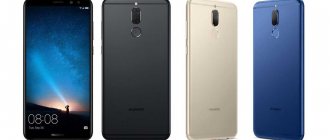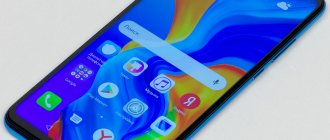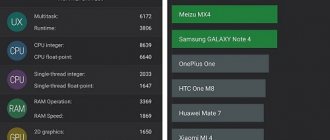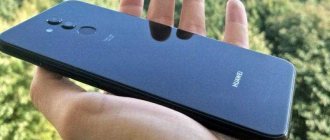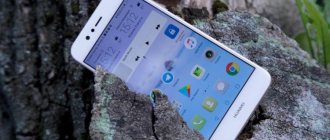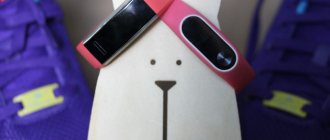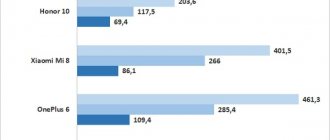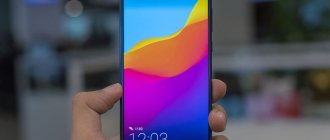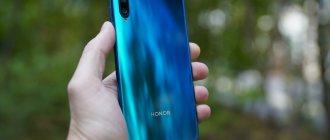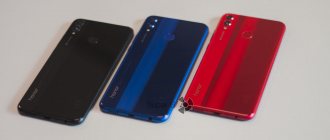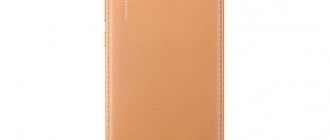Huawei marketers have divided the company's smartphones into four series: Y ( y outh - young), G ( g old - gold), P ( platinum - platinum) and D ( diamond - diamond). It’s easy to guess that the first two classes include entry-level and mid-level devices, and the D series includes technically advanced flagships. Huawei's “platinum” smartphones (to which, accordingly, Ascend P6 belongs) stand apart, since, on the one hand, they are equipped with quite good technical components, with which it is not a shame to pretend to be the main device of the company, and on the other hand, they have very pleasant appearance. It’s not for nothing that the press release of the tested gadget began with the words: “Introducing Ascend P6: Huawei’s new designer flagship - the thinnest smartphone in the world.” Therefore, despite the fact that the device does not belong to the company’s highest D-class, it is also considered a flagship, and not just a simple one, but a designer one.
⇡#Appearance and ergonomics
You can have a long discussion on the topic “whether or not the race for better performance figures is advisable.” If we talk about the dimensions of the smartphone, LG engineers, for example, believe that it is better for the device to be a millimeter thicker, but it will accommodate a more capacious battery. There is certainly logic in such judgments, but one thing cannot be denied: thin smartphones look really cool.
Huawei Ascend P6 - front panel
The body of the device is made almost entirely of aluminum, which ensures sufficient structural strength. The gadget withstood the compression of the sides without creaking a single part, and there were no characteristic color stains on the screen either. The build quality is very high. At the same time, the device weighs relatively little - 120 grams.
Huawei Ascend P6 front view
The only plastic element in the entire case is a rounded insert at the bottom. It slightly spoils the appearance of the smartphone - without it the gadget would look more harmonious.
Huawei Ascend P6 with screen on
As befits a device running the fourth version of Android, there are no physical keys on the front panel, so its main area is occupied by the screen. The thickness of the frame around the display on the sides is kept to a minimum - it does not even reach two millimeters. At the top of the panel there is a slot for the earpiece and the front camera lens.
Huawei Ascend P6 - general view
When you first get acquainted with the device, your eyes involuntarily notice numerous nuances in which it is similar to Apple smartphones of the fourth and fifth generations. The most noticeable of all are the sides of the case, made of aluminum with characteristic “seams” at the top. In this case, it is absolutely possible to answer the question of what device Huawei designers were inspired by. On the right side of the case there are power keys, volume control keys, as well as connectors for MicroSD and micro-SIM, which, like in the same smartphone, are opened using a needle key.
Huawei Ascend P6 - back panel and sides
However, Huawei engineers did not hide the needle in a bag of documents, but combined it with a plug for the audio jack. They probably hoped that it would be harder to lose her this way. However, the Ascend P6 arrived to us without the ill-fated needle - it seems that one of those who tested the smartphone before us was still able to sow it. The micro-USB interface, from which the device is charged, is located at the top end. Next to it is one of the microphones, the second is hidden on the bottom edge.
Huawei Ascend P6 - rear panel
The back of the device is textured but smooth, which can make the device slip out of your hands. In its upper part there is a lens of the main 8-megapixel camera and a flash, in the lower part there is a slot for an external speaker. Not a single element protrudes from the case, so the declared thickness of 6.2 mm can be considered absolutely fair. The back cover of the Huawei Ascend P6 is non-removable, which eliminates the possibility of hot-swapping the battery.
Huawei Y3 2021 review
Huawei Y3 2021 is an inexpensive smartphone that represents the manufacturer’s youngest line. The device was announced in April 2021. Its main feature is the price, which is set at a minimum level.
Appearance and ergonomics
The body of the affordable Huawei U3 2021 phone is made of plastic. Its shape resembles a classic rectangle with rounded corners. There is a decorative frame around the perimeter that imitates metal. At the back there is not only the main camera, but also a logo, a multimedia speaker and a flash.
There are no different elements under the display, as only virtual buttons are used for navigation. The device is comfortable to hold in your hand because it is light and small in size, and its body has an ergonomic shape. Available colors: white, pink, blue and gold.
Display
The Y3 2021 smartphone is equipped with a 5-inch screen with a resolution of 854 by 480 pixels. The display is made using IPS technology. Although its resolution is minimal, the picture quality does not suffer much from this. Viewing angles are good, and the image indoors remains of very high quality.
Hardware and performance
It is worth noting that the U3 2021 is available in two versions at once - with a MediaTek MT6580 processor (1300 MHz) or with a MediaTek MT6737M chip. These are modern quad-core solutions. But the latter option has a lower frequency (1100 MHz), but a powerful Mali-T720 MP2 graphics accelerator. The amount of RAM is 1 GB, and the internal storage capacity is 8 GB. There is a separate slot for a memory card (maximum capacity 128 GB).
The device cannot boast of high performance, so it is hardly suitable for modern mobile games with colorful special effects. But it copes with everyday tasks, but multitasking can still be a problem. The Android 6.0 operating system with EMUI 4.1 shell is offered to the user right out of the box.
Communication and sound
The multimedia speaker in Huawei Y3 2021 is quite simple, purely budget (lots of high frequencies, but few lows and mids). At the same time, it’s pleasant to talk with your interlocutors; there is no discomfort from communication. A more advanced version of the device with the MediaTek MT6737M chip supports LTE networks.
Camera
The Huawei U3 2021 has a main 8-megapixel camera, which takes decent pictures during the daytime. There are additional settings, as well as interesting functions that will help diversify the shooting process. The front 2-megapixel camera is suitable for photographing documents and simple self-portraits.
conclusions
The new Y3 2021 turned out to be quite an attractive option for anyone who wants to buy their first Android smartphone. Also, this $60 model is suitable for the younger generation who cannot spend a lot of money on flagships.
Pros:
- Very low price.
- Nice design.
- Excellent ergonomics.
- Beautiful EMUI shell.
- Availability of LTE (in the older model).
Minuses:
- Relatively low performance.
- Small amount of memory.
⇡#Technical characteristics
| Huawei Ascend P6 | |
| Display | 4.7 inches, 720×1280, IPS |
| Touch screen | Capacitive, up to ten points, support for working with gloves |
| Air gap | Absent |
| Oleophobic coating | Eat |
| Polarizing filter | Eat |
| CPU | Huawei HiSilicon K3V2E: four cores ARM Cortex-A9 (ARMv7), frequency 1.5 GHz; Process technology 40 nm |
| Graphics controller | Vivante GC4000 |
| RAM | 2 GB |
| Flash memory | 8 GB + MicroSD |
| Connectors | 1 x micro-USB 2.0 (MHL) 1 x 3.5 mm headset jack 1 x MicroSD 1 x micro-SIM |
| cellular | 2G: GSM/GPRS/EDGE 850/900/1800/1900 MHz 3G: HSPA+ (21 Mbit/s) 850/900/1700/1900/2100 MHz |
| Bluetooth | 4.0 |
| WiFi | 802.11b/g/n |
| NFC | Absent |
| IR port | Absent |
| FM radio | Eat |
| Navigation | GPS, A-GPS, GLONASS |
| Sensors | Illumination, proximity, accelerometer/gyroscope, digital compass |
| Main camera | 8.0 MP (3264×2448), back-illuminated sensor, autofocus, LED flash |
| Front-camera | 5 MP (2592×1952) |
| Nutrition | Non-removable battery: 7.4 Wh (2000 mAh, 3.7 V) |
| Size | 133x65.5 mm Case thickness 6.2 mm |
| Weight | 120 g |
| operating system | Android 4.2.2 Jelly Bean Emotion UI 1.6 shell |
| Price | From 16,990 rubles |
Huawei Ascend P6 - information about the system and hardware
Technical characteristics of Huawei Y3 2021
| General characteristics | |
| Model | Huawei Y3 2021, Huawei Y5 Lite 2021 CRO-L02, CRO-L03, CRO-L22, CRO-L23, CRO-U00 |
| Date of announcement/start of sales | May 2021 / summer 2017 |
| Dimensions | 145.1 x 73.7 x 9.5 mm. |
| Weight | 175 g. |
| Case color range | Gold, silver, pink, blue and white |
| Number and type of SIM cards | Dual SIM |
| operating system | Android 6.0 (Marshmallow) |
| Communication standard in 2G networks | GSM 850 / 900 / 1800 / 1900 - SIM 1 & SIM 2 |
| Communication standard in 3G networks | HSDPA 850 / 900 / 1900 / 2100 |
| Communication standard in 4G networks | LTE |
| Display | |
| Screen type | IPS LCD capacitive touchscreen, 16 million colors |
| Screen size | 5 inches |
| Screen resolution | 480 x 854 @196 ppi |
| Multitouch | There is |
| Screen protection | |
| Sound | |
| 3.5mm jack | There is |
| FM radio | There is |
| Additionally | |
| Data transfer | |
| USB | microUSB 2.0 |
| Satellite navigation | GPS (A-GPS) |
| WLAN | Wi-Fi 802.11 b/g/n, hotspot |
| Bluetooth | 4.0, A2DP |
| Internet connection | LTE, HSPA, EDGE, GPRS |
| NFC | No |
| Platform | |
| CPU | Mediatek MT6737M (1.1 GHz Cortex-A53) - CRO-L02/CRO-L22/CRO-L03/CRO-L23 Mediatek MT6580M (1.3 GHz Cortex-A7) - CRO-U00 |
| GPU | Mali-T720MP2 - CRO-L02/CRO-L22/CRO-L03/CRO-L23 Mali-400MP2 - CRO-U00 |
| RAM | 1 GB RAM |
| Inner memory | 8 GB |
| Supported memory cards | microSD up to 128 GB |
| Camera | |
| Camera | 8 MP, f/2.0, autofocus, LED flash |
| Camera functions | Geo-tagging, touch focus, face detection |
| Video recording | [email protected] |
| Front-camera | 2 MP |
| Battery | |
| Battery type and capacity | 2200 mAh, non-removable |
| Additionally | |
| Sensors | Illumination, proximity, accelerometer |
| Browser | HTML5 |
| IMAP, POP3, SMTP | |
| Other | — Google Search, Maps, Gmail, Talk — MP4/H.264 player — MP3/WAV/eAAC+ player — Document viewer — Photo/video editor — Organizer — Voice dialing, voice commands, voice recording |
| Equipment | |
| Standard equipment | Y3 (2017): 1 USB cable: 1 SIM eject tool: 1 User manual: 1 Warranty card: 1 Charger 5V / 1A: 1 |
⇡#Options
Huawei Ascend P6 has a fairly rich package for its class. In the box, in addition to the device itself, we found the following accessories:
- USB cable ↔ microUSB;
- Silicone case for the back panel;
- Charger with USB connector 1 A;
- In-ear headphones with call answer key;
- Warranty card and user manual in Chinese.
Future owners of the smartphone will not need to buy anything additional for it - everything comes with the Huawei Ascend P6, which is undoubtedly good.
⇡#Display
Huawei Ascend P6 uses a 4.7-inch screen with a resolution of 720x1280 pixels. The pixel density exceeds 312 ppi - quite retina. The five-inch flagship Ascend D2, by the way, has a Full HD display and more than four hundred and forty dots per inch - here it is, an almost invisible difference between P and D. One way or another, for such a diagonal, the resolution of the Ascend P6 display is excellent. No more is needed, it will just waste the battery.
Huawei Ascend P6 - AnTuTu MultiTouch Test results
The matrix is based on IPS technology, thanks to which the display has excellent viewing angles, and colors remain true to life, even if you look away from normal. The device quickly and accurately recognizes touches and gestures and can understand up to ten simultaneous touches of the screen. The smartphone display is covered with protective Gorilla Glass, which reliably protects it from scratches and other damage.
The Huawei Ascend P6 display has a very large brightness reserve. The luminosity of the white field varies from 32 to 470 cd/m2 - at the minimum and maximum backlight levels, respectively. Due to the fact that the screen is equipped with an oleophobic coating, thanks to which it does not get dirty so quickly, as well as a polarizing layer, the information on it remains readable even outdoors under the bright sun. At the same time, the display does not force your eyes in pitch darkness - its brightness limits are very wide.
High screen brightness is necessarily associated with an increase in the luminosity of the black field, which in this case reaches 0.54 cd/m2. Because of this, at the maximum backlight level, the black color lacks some depth. Not critical, but noticeable. The total contrast (measured in a simple way - on screens completely filled with white and black) is set at 865:1 - generally good for IPS, but it could be higher.
In terms of basic indicators, the Huawei Ascend P6 display is quite good. However, if you look at it in more detail, it becomes clear that it is not calibrated in the best way. The color temperature of ten shades of gray is noticeably higher than normal - on average it is about 8250 K versus the reference 6500 K. This means that the colors on the display look a little “cooler” than they should. For those who are particularly bothered by this, the corresponding section of the settings provides a function for manually adjusting the color temperature.
Huawei Ascend P6 - adjusting color temperature
The grayscale gamma curve is almost identical to the standard. This means that the image is free from overexposure and “dips” in the shadows at any backlight level. With the gamma curves of color components, things are much worse. This is especially true for the blue component - it is the most overexposed, hence the “cold” tones. Green and red are also oversaturated, but such deviations from the standard curve are forgivable.
The color gamut of the display practically coincides with the sRGB space - it is only slightly narrower. In general, multimedia files look quite good on the Huawei Ascend P6 screen - rich and detailed, without visible deviations, although the screen should have been adjusted more carefully - there are some shortcomings.
Huawei Ascend P6 - smartphone screen color gamut (black triangle) compared to sRGB color space (white triangle)
Design and ergonomics
Users who actively follow the mobile market will immediately recognize the Y6s as the already iconic first-generation Google Pixel smartphone. It was produced in the same colors and combined two options for finishing the back, but unlike the Pixel, which was made of glass and metal, the Huawei Y6s is made entirely of plastic. For a device that costs 8 thousand rubles, there is nothing wrong with this, except that you still have to buy a case - the plastic, although tactilely pleasant and feels confident in the hands, quickly becomes covered with scratches and abrasions.
At the top of the back panel of the Y6s there is a single front camera and a round fingerprint scanner. The camera practically does not protrude, so you can use the phone lying on the table without any problems. The scanner is located at a convenient height, and there are no questions about its performance either - it works quickly and accurately. Alternatively, you can use face unlock. When the phone recognizes you, there is no need to do an additional swipe on the screen, the home screen immediately opens.
The Huawei Y6s display is surrounded by not the thinnest bezels, which is typical for budget devices. The most massive chin here is occupied by the Huawei logo. At the top of the display there is a waterdrop-shaped cutout, which houses the front camera, earpiece and LED notification indicator.
At the top there is a 3.5 mm headphone jack and a hole for a noise-canceling microphone. At the bottom are the speaker grilles and a micro-USB charging port. Only the right grille produces sound, while the main conversation microphone is hidden under the left one.
The volume key and power button are located on the right side.
On the opposite side there is a tray for two SIM cards with a separate slot for a MicroUSB memory card.
As for ergonomics, Huawei Y6s is a very light and fairly compact smartphone, which is quite comfortable to use with one hand. It can be a real outlet for users who are tired of 7-inch shovels.
⇡#Sound
The external speaker of Huawei Ascend P6 boasts good sound detail, neat high frequencies and non-wheezing lows, and, most importantly, a very decent volume reserve. For such a thin body this is perhaps somewhat unusual. The earpiece allows you to hear your interlocutor even in noisy places - in the subway or on a busy street.
Huawei Ascend P6 - choosing a Dolby Digital Plus filter
The smartphone is equipped with Dolby Digital Plus filters with the ability to select the genre of the track or movie being played. Essentially, this is a regular equalizer without manual settings. The device knows sixteen “presets” for audio and nine for video. True, they are not very useful - there are no fundamental changes in the sound. Dolby Digital Plus filters can only be used when a headset is connected.
⇡#Hardware and performance
Huawei is one of the few companies that produces systems-on-a-chip for its smartphones and tablets independently. The production of platforms is carried out by a subsidiary of HiSilicon, founded in 2004. Ascend P6 is built on one of the company's fastest platforms - K3V2E (40nm process technology), the same one that powers the D2, P2, Honor 2 smartphones and the MediaPad 10 FHD tablet. The masses like this chip because it is quad-core. In fact, it is no longer so good, since a) the processor uses older ARM Cortex-A9 cores and b) the chip is produced using an outdated 40 nm process technology. The smartphone is equipped with two gigabytes of RAM.
The built-in storage capacity is 8 GB, of which slightly less than five are available to the user. Despite the very thin body, the manufacturer did not abandon the slot for MicroSD memory cards, so users will not have to complain about the small storage capacity.
In the Linpack profile test, the chip from HiSilicon did not perform the best - as expected. Qualcomm's Krait cores are noticeably faster.
In the Quadrant 2 Standard synthetic test, the gadget received a very competitive score - approximately five and a half thousand points. Of course, devices based on modern Qualcomm processors are faster, but the difference is not that great. During everyday work, Huawei Ascend P6 practically does not slow down, smoothly displays the operating system animation, keeps several open applications in memory and quickly switches between them. In general, if you do not overload the device, it works smoothly.
With the playback of multimedia files, things are generally good, but not perfect. The smartphone can smoothly play videos with a resolution of 720p, but Full HD 1080p is no longer easy for it - the video sequence slows down when watching movies in high definition.
The Vivante GC4000 is used as a graphics controller - it is far from the fastest video accelerator, so avid gamers are unlikely to like the Huawei Ascend P6. In a simple synthetic test Nenamark 2, the gadget almost hit the upper limit - 60 FPS, and on average in terms of complexity Basemark 2 Taiji showed 30 frames per second, which is not bad - but by the standards of processors of this year of release, not so much.
In the most severe “gaming” tests, the results were unimportant. In the normal Ice Storm task, the device scored 2,750 points, and in the extreme task, just over one and a half thousand. Various “heavy” games like Real Racing 3 and Asphalt 8: Airbone launch, but the picture in them periodically slows down, and the smartphone itself gets noticeably warm. However, taking into account the weather conditions in Russia, the latter can be considered a plus.
3DMark test results | Basemark X test results |
Test review of the budget smartphone Huawei Ascend Y300
From the editor.
We continue our series of test-reviews of smartphones, cameras, tablets, laptops and other gadgets needed by a modern person.
The review consists of two parts. In the first, we give the floor to an ordinary user (the so-called “teapot”
). In the second part, the Gazeta.Ru expert evaluates the device from the point of view of relevance, convenience and prospects.
The editors invite Gazeta.Ru readers to take part in the discussion: if you have used the device discussed in the review, please rate it on a five-point scale in the comments to this material and tell us why you liked or disliked it.
Information about devices is published free of charge. The editors may not share the views of the authors of published opinions.
Opinion of Nikolay Shinkarev, traffic manager
The Y300 is definitely not a device you can use to impress your friends and colleagues. Neither his appearance, nor his capabilities... Although no, he can make an impression - at his own cost.
Actually, my entire “report” on testing the Y 300 can be reduced to a discussion on the topic: is it worth paying 6 thousand for it or not? Obviously, it’s stupid to compare the Y300 with smartphones like the Galaxy S4, HTS One or Xperia Z, with a 4-5 times difference in price.
I love expensive IT toys and, if it weren’t for the toad that was choking me, I would change my smartphone every year to a new flagship model. But, of course, this is not the most reasonable behavior. 90% of my friends change their phones (by no means the most expensive) about once every 2-3 years. And, you won’t believe it, many of them bought their first smartphone only in 2012 or 2013; before that, many had “just phones.”
Returning to the Huawei Y 300: the 4-inch screen of the device is like the iPhone 5, in the sense of the same size. Unfortunately, the similarities between these two displays end there. With a resolution of 800x480, the clarity of the Y300 screen is approximately one and a half times less than that of the iPhone 5. It is quite possible to live with such a screen, but the difference with the screens of top models is noticeable, not only in image clarity, but also in contrast and brightness. The screen goes blind in the sun. For calls this is not very important, the dial buttons are large and visible, but for reading, Internet surfing and especially for video photography, this is critical.
As for the camera, you can't expect miracles from a 5-megapixel module. More or less decent pictures are obtained only in good daylight.
I had no complaints about the communication module, no jambs were observed. Subscribers were clearly audible even with one bar on the signal strength indicator.
Audio player: not NTS with its beats audio, of course, but it’s quite possible to listen to music. I didn’t even test the video player, because... watching movies on a 4-inch screen, in my opinion, is already a perversion.
And now the best part: firstly, the device hardly slowed down (though I didn’t run hardcore games on the Y300), secondly, with not very intensive use, the Y300 worked for three days, and with more active use – for two days. Excellent result, without any discounts for budget, etc.
Result:
A device from the “workhorse” series, and a very budget “horse”. The fact that he has his own target audience is 100%. Firstly, not everyone in Russia has Moscow salaries. Secondly, there are people, and there are a lot of them, who think that spending 30 thousand on a smartphone is crazy.
Argue with Nikolay Shinkarev
Agree with Nikolay Shinkarev Rate Huawei Ascend Y300
Opinion of Oleg Kapranov, IT columnist for Gazeta.Ru
Huawei is consistently updating its line of mobile devices: Ascend D2, Ascend Mate... The time has come for a new gadget in the budget segment. It was the Huawei Ascend Y300 smartphone, designed, as the company says, for a youth audience.
“Youth” means, firstly, inexpensive, and secondly, designed to work with social networks, multimedia content and games. It was with these expectations that we approached testing the new product.
Externally, the device is in many ways similar to its more expensive relative Ascend D2: the same body color, only the design is a little simpler and smaller in size. The device is compact and fits well in the hand. The buttons are convenient, but the USB cable connector seemed a little sloppy. The “flimsy” back cover is also confusing.
The interface control buttons are placed in a separate area of the display and are marked with corresponding icons - you can give a plus for this.
The smartphone turned out to be quite light (weight: 130 g), and its dimensions are quite adequate to the size of a 4-inch screen: 63.8 x 124.5 x 11.2 mm.
The display is of average quality. Of course, in a device of this price level there was no question of an expensive IPS matrix, so the manufacturer used a TFT-LCD matrix. This affects the image quality. If you use your smartphone outdoors in bright sunlight, the display will become hopelessly blind. The most difficulties arose when testing the camera on a sunny day: often nothing was visible in the viewfinder.
In less light conditions - indoors, in transport - the picture turns out quite good, the colors are natural, without the “acidity” of AMOLED displays. The screen resolution is 480x800, which is somewhat archaic today, but expecting an HD display in a phone for 6,000 rubles would be naive. At least not this year. What was surprising was the use of a completely non-budget Qualcomm Snapdragon, more precisely, the MSM8225 platform, when creating a budget device. The processor is dual-core, frequency is 1 GHz, but, nevertheless, it is Qualcomm. Manufacturers, as a rule, try to make inexpensive smartphones on cheaper MTK platforms.
In addition to a decent processor, the gadget is equipped with 512 MB of RAM and 4 GB of memory for data storage, of which approximately 1 GB is available to the user, which, of course, by modern standards, is quite a bit. In such a situation, the use of memory cards becomes an absolute necessity; accordingly, the Y300 is equipped with a slot for MicroSD cards.
The overall performance of the system is far from top-end smartphones, but the interface does not slow down, and this, in this case, is the most important thing. During tests, there were no problems with braking when surfing the Internet.
Despite the modest hardware, the device has a fairly powerful battery - 1730 mAh, which allows the smartphone to work without being connected to a charger for about two days.
The Y300 runs on the Google Android 4.1 operating system - not the newest version, but quite modern. Huawei's proprietary interface, Emotion UI1.0, is installed on top of the operating system. This shell can be seen in other devices of the company; there are practically no differences. The key feature is that all applications are located on desktops.
It remains to say a few words about the smartphone camera. A modest 5-megapixel camera can satisfy not the most demanding users. Suffice it to say that the resolution when shooting video is limited to 640x480 pixels - this is very little even by the standards of budget devices. Color reproduction is subdued, colors are a little dull. At the same time, the camera interface is fast, the Y300 does not have problems with the interface slowing down during prolonged camera operation, which was observed in the Ascend D2.
Brief testing results:
Huawei Y300 is, overall, a good smartphone when we consider it among budget smartphones from other manufacturers. Quite a successful combination of a mid-range hardware platform and a capacious battery. A good set of communications - Wi-Fi, Bluetooth, USB. But the camera, in our opinion, is too modest. It's enough to post photos on Facebook, but nothing more. On the other hand, maybe this is the main task for the photo module of a “youth” device?
Argue with Oleg Kapranov
Agree with Oleg Kapranov Give your rating Huawei Ascend Y300
Editorial.
We invite Gazeta.Ru readers to take part in the discussion of Huawei Ascend Y300. If you have used the device discussed in the review, please rate it on a five-point scale in the comments to this material and tell us why you liked or disliked it.
⇡#Communication
Huawei Ascend P6 is equipped with a completely standard set of wireless modules, including Bluetooth 4.0, Wi-Fi b/g/n and GPS with GLONASS support. All systems work properly, without any complaints. Through the “blue tooth”, files are transferred moderately quickly, music tracks are transmitted to wireless speakers without jams.
The device easily connects to both home and public access points. Data is received at an understandable speed even when moving away from the transmitter. The average data exchange speed on a home Wi-Fi network was about 1.25 MB/s for reception and upload, which is more than enough for comfortable browsing on the Internet. With a stable connection, the device plays streaming video in 720p without lag.
Results of the Wi-Fi Analyzer test in a home Wi-Fi network at a distance of five meters from the router | SpeedTest results |
GPS and GLONASS modules are responsible for navigation in the smartphone. In less than a minute after a cold start (that is, without hints from the Internet), the device detected 15 satellites, but was guided by only four or five. However, even this was enough for accurate navigation. When Wi-Fi is turned on, the speed and accuracy of terrain orientation significantly increase.
Huawei Ascend P6 - GPS Test results
The Huawei Ascend P6 does not have an NFC module or support for fourth-generation mobile networks, so future users will have to be content with 3G capabilities. There are no complaints about the modem; the device does not lose the network for no apparent reason.
Huawei Y6s price and specifications
- Screen: 6.09″, IPS, HD+ (1560×720 px), 19.5:9, 282 ppi;
- Processor: Mediatek MT6765 (8×1.8-2.3 GHz, 12 nm), PowerVR GE8320 graphics;
- Permanent memory: 64 GB (eMMC 5.1) + MicroSD up to 512 GB (separate slot);
- RAM: 3 GB (LPDDR3);
- Main camera: 13 MP (f/1.8, PDAF), LED flash, video 1080p/30fps;
- Front camera: 8 MP (f/2.0);
- Battery: 3020 mAh;
- SIM: 2 x Nano;
- Wireless communications: LTE, Bluetooth 4.2, Wi-Fi 802.11n, GPS, NFC.
- Ports: MicroUSB (2.0), 3.5 mm jack;
- Security: fingerprint scanner, Face Unlock;
- OS: Android 9 + EMUI 9.1;
- Dimensions: 156.3 x 73.5 x 8 mm, weight – 150 grams.
- Color: blue, black.
The official price of Huawei Y6s in Russia is 8,990 rubles, but in online stores you can easily find a new product for a thousand and a half cheaper.
⇡#Autonomous work
Ascend P6 is powered by a non-removable lithium polymer battery with a capacity of 7.4 Wh (2000 mAh, 3.7 V). For a modern smartphone with a bright screen and a quad-core processor produced using a “rough” technological process, this is a low capacity. Obviously, such a battery is a sacrifice that had to be made to make the gadget so thin. In the synthetic AnTuTu test, the device scored 439 points, draining at maximum screen brightness, with an active Wi-Fi connection from 100% to 19% in two and a half hours - quite quickly.
Huawei Ascend P6 - AnTuTu Battery Test results
It's actually not that bad. Under moderate loads, the smartphone's battery will definitely last for a working day, and with correctly configured energy consumption parameters, you can count on a day of use. Even if the gadget suddenly runs out of power, it’s not difficult to find a charger for it - the Ascend P6 is powered by the popular micro-USB. When continuously watching videos at maximum display brightness, the device discharged in just over four hours. In reading mode with minimal screen backlight, the smartphone asked to be charged after twelve hours.
Results
Its main advantages of the HUAWEI Ascend Y320 include a high-quality body and thoughtful ergonomics. The disadvantages are the camera and screen. The absence of a light sensor is a typical feature of inexpensive smartphones.
Liked + Ergonomics + Housing + Cost
Didn’t like it - Camera - Display - Lack of light sensor
The product was provided for testing by HUAWEI, consumer.huawei.com/ua
| HUAWEI Ascend Y320D (Black) Notify when available | |
| Type | Smartphone |
| Standard | GSM 850/900/1800/1900, UMTS 900/2100 |
| High speed data transfer | GPRS, EDGE, HSDPA, HSUPA |
| SIM card type | Mini-SIM |
| Number of supported SIM cards | 2 |
| operating system | Android 4.2 (Jelly Bean) |
| Type of shell | monoblock |
| Keyboard type | screen input |
| Dimensions, mm | 123,3×63,2×11,1 |
| Weight, g | 123 |
| Protection from dust and moisture | — |
| Accumulator battery | Li-Ion, 1350 mAh |
| Operating time (manufacturer's data) | no data |
| Diagonal, inches | 4 |
| Permission | 480×800 |
| Matrix type | TFT |
| PPI | 233 |
| Dimming sensor | — |
| Touch screen (type) | touch (capacitive) |
| Other | 16 million colors |
| CPU | MediaTek MT6572 + GPU Mali-400MP |
| Kernel type | Cortex-A7 |
| Number of Cores | 2 |
| Frequency, GHz | 1,3 |
| RAM, MB | 512 |
| Built-in memory, GB | 4 |
| Expansion slot | microSD (up to 32 GB) |
| Main camera, MP | 2 |
| Autofocus | — |
| Video shooting | There is |
| Flash | LED |
| Front camera, MP | — |
| Other | digital zoom |
| WiFi | 802.11 b/g/n, Wi-Fi hotspot |
| Bluetooth | 3.0 |
| GPS | + |
| IrDA | — |
| NFC | — |
| Interface connector | USB 2.0 (micro-USB) |
| Audio jack | 3.5 mm |
| MP3 player | + |
| FM radio | — |
| More | gyroscope, accelerometer, A-GPS receiver, vibration alert, DNLA support |
Specifications
| HUAWEI Ascend Y320D (Black) Notify when available | |
| Type | Smartphone |
| Pre-installed OS | Android 4.2 (Jelly Bean) |
| RAM, GB | 0,5 |
| Built-in memory, GB | 4 |
| Expansion slot | microSD/SDHC (up to 32 GB) |
| SIM card type | Mini-SIM |
| Number of SIM cards | 2 |
| CPU | MediaTek MT6572 + GPU Mali-400MP |
| Number of Cores | 2 |
| Frequency, GHz | 1,3 |
| Battery | Li-Ion, 1350 mAh |
| Diagonal, inches | 4 |
| Permission | 800x480 |
| Matrix type | TFT |
| PPI | 233 |
| Dimming sensor | — |
| Display Features | 16 million colors |
| Main camera, MP | 2 |
| Video shooting | There is |
| Flash | — |
| Front camera, MP | — |
| Camera Features | digital zoom |
| Communication standards | GSM 850/900/1800/1900, UMTS 900/2100 |
| WiFi | 802.11 b/g/n, Wi-Fi hotspot |
| Bluetooth | 3.0 |
| GPS | + |
| IrDA | — |
| FM radio | — |
| Audio jack | 3.5 mm |
| NFC | — |
| Interface connector | USB 2.0 (micro-USB) |
| Height, mm | 123,3×63,2×11,1 |
| Weight, g | 123 |
| Protection from dust and moisture | — |
| Type of shell | monoblock |
| Case color | black |
| Keyboard type | screen input |
| More | gyroscope, accelerometer, A-GPS receiver, vibration alert, DNLA support |
⇡#Camera
Of particular interest in the case of Huawei Ascend P6 is the front camera. The fact is that it is 5-megapixel, which is unusual even for more expensive flagship models. This allows you to make video calls and take self-portraits in low light. The picture, of course, will be covered in noise, but at least it will be readable.
Huawei Ascend P6 - Camera app interface
The main camera of the smartphone is 8 megapixel. It is equipped with all the standard functions for digital point-and-shoot cameras: burst shooting, smile detection, geotags and much more. Users also have the ability to manually set white balance, light sensitivity and other shooting parameters. However, there is no need to go into the settings for no apparent reason - the automation copes with everything perfectly.
Shooting in ample light - HDR off | Shooting in ample light - HDR enabled |
In good lighting, the rear camera of the Huawei Ascend P6 takes pictures very well. The photos are rich, contrasty and well detailed. The only shortcoming that should be noted is the sharpness falling towards the edges of the frame, but many competitors are guilty of this. The camera is equipped with a switchable High Dynamic Range (HDR) mode, which skillfully corrects shadow gaps and highlights, making the photo more attractive.
Shooting text
The rear camera is equipped with an autofocus system, allowing you to shoot subjects at close range. The device is focused quickly enough and with virtually no misses. Autofocus only makes mistakes in low light.
Shooting indoors
Images taken in indoor lighting conditions become less saturated and deep, but retain an acceptable level of detail. However, you can’t count on shooting in the evening and at night using the Huawei Ascend P6.
Shooting at night
The smartphone can stitch together panoramas and shoot video in high definition. A minute of recorded video takes up approximately 130 MB of disk space.
Shooting a panorama
⇡#Software
Lock screen | Main desktop |
Ascend P6 runs Android 4.2.2 Jelly Bean operating system with proprietary Emotion UI 1.6 interface. Huawei’s “Launcher” turned out to be very nice - the icons are drawn in detail, the colors of the widgets and wallpapers are chosen harmoniously. The main difference between this interface and the standard one is the absence of an application menu. All shortcuts are placed directly on one of the desktops - a common occurrence in Chinese smartphones. Otherwise, we have a typical “Android”, albeit repainted to the taste of Huawei designers.
Huawei Ascend P6 - standard applications
The system is delivered in an unabridged version - all standard programs are in place, they are placed in a separate folder on the desktop. In addition to them, the manufacturer has built into the shell some of its own and third-party applications - a file manager, its own “gallery” and music player, FM radio that only works with connected headphones that act as an antenna, a “reader” for office documents, and even a flashlight. The selection of programs turned out to be successful - there is nothing superfluous in it, all the programs are very useful. If necessary, the user can remove unnecessary applications - they are not tightly sewn into the shell.
Interface
The smartphone runs the Android 4.2.2 Jelly Bean operating system without the Emotion UI graphical interface, which is familiar to us from the company’s older devices. Since the device is powered by a processor that is not the most powerful, this decision is completely justified. Another pleasant thing was that the manufacturer did not clutter up the memory with third-party applications. As a result, among the pre-installed software you can find Google services programs, applications from HUAWEI - “Backup” and “File Manager”.
